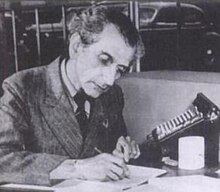Cornelius Lanczos | |
|---|---|
 | |
| Born | February 2, 1893 |
| Died | June 25, 1974 (aged 81) |
| Nationality | Hungarian |
| Alma mater | University of Budapest University of Szeged |
| Known for | Lanczos algorithm Lanczos tensor Lanczos resampling Lanczos approximation Lanczos sigma factor Lanczos differentiator Lanczos–van Stockum dust |
| Spouse(s) | Mária Erzsébet Rump (1928–1939) Ilse Hildebrand (1954–1974) |
| Awards | Chauvenet Prize (1960)[1] |
| Scientific career | |
| Fields | Mathematics Theoretical physics |
| Institutions | University of Freiburg Purdue University Boeing Institute of Numerical Analysis Dublin Institute for Advanced Studies Frankfurt University |
| Thesis | Relation of Maxwell's Aether Equations to Functional Theory (1921) |
| Doctoral advisor | Rudolf Ortvay |
| Other academic advisors | Loránd Eötvös Lipót Fejér, Erwin Madelung |
Cornelius (Cornel) Lanczos (Hungarian: Lánczos Kornél, pronounced [ˈlaːnt͡soʃ ˈkorneːl]; born as Kornél Lőwy, until 1906: Löwy (Lőwy) Kornél; February 2, 1893 – June 25, 1974) was a Hungarian-Jewish, Hungarian-American and later Hungarian-Irish mathematician and physicist. According to György Marx he was one of The Martians.[2]
- ^ Lanczos, Cornelius (1958). "Linear Systems in Self-Adjoint Form". Amer. Math. Monthly. 65 (9): 665–679. doi:10.2307/2308707. JSTOR 2308707.
- ^ A marslakók legendája Archived 2022-04-09 at the Wayback Machine – György Marx.